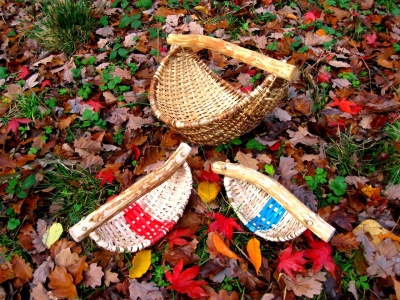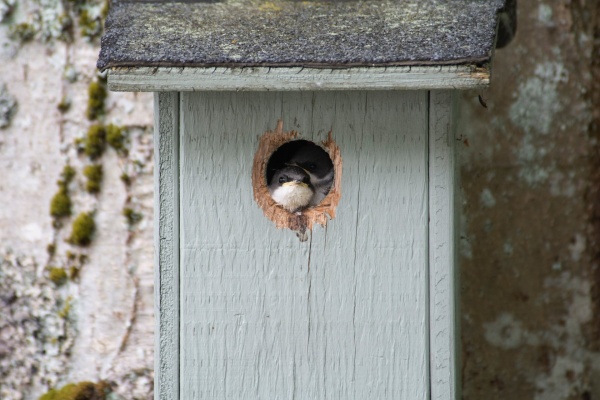
Make a split hazel 'swallow's nest' basket
- The Green Wood Centre
- 05 Jul 2025
18 Feb 2022

Photo by Mariko margetson on Unsplash
Small hole nest box - The most common type of nest box you’ll find in the shops is a small hole nest box. Favoured by small birds such as bluetits, it consists of a box (usually wooden) with a sloping lid and a 25mm entrance hole. Blue tits will line the box with soft materials such as moss and feathers, and while eggs will be incubated for up to 2 weeks, the babies won’t stay in their nest box for long, fledging just 4-5 days after hatching.
Open-fronted nest box - Birds such as robins and wrens prefer to nest in open-fronted nest boxes. You may have seen photographs of robins building nests in tea pots or old boots, but you can also buy or make special nest boxes to suit their needs. Robins are very wary nesters, and much prefer a sheltered spot for their nest, away from humans and feeding stations. Try placing these nest boxes amongst climbing vegetation where there are lots of places to hide.
Large hole nest box - Larger birds such as starlings need a bigger box with a bigger hole – around 45mm in diameter. Starlings often nest communally, so several of these nest boxes can be placed close together to provide a haven for these beautiful and boisterous birds.
Tawny owl nest box - If you have spent any time in woodland at night, you’ll be familiar with the classic “twit” and “twoo” calls of the tawny owl. It may be a surprise that such a large bird will use a nest box, but owls have to live somewhere too, and a large box can be just the place for them to make their home. Tawny owl boxes must have an entrance hole no smaller than 200mm square, and can be attached to a post or a tree trunk. Click here for the Barn Owl Trust’s handy guide to making your own tawny owl nest box.
Remember, nest boxes aren’t just for birds! Many other animals will appreciate a ready-made home in your garden or woodland!
Bats - The UK is home to 17 species of bat, making up almost a quarter of all native mammals. Bats don’t construct roosts but use structures that are already available, so bat boxes can be the perfect place for a colony of bats to call home.
Bat boxes are usually rectangular wooden boxes with a narrow entrance slit at the bottom and a grooved ‘bat ladder’ or rough piece of wood to allow the bats to climb up inside the box with their tiny claws. Bats are very picky about their houses and prefer well insulated boxes with tight joints to prevent a draught!
While many species of bat love to hunt in woodland, they prefer to nest around 6m away from trees, so bat boxes can be hung in sunny spots on buildings or posts near to the tree line. Once bats have inhabited the box, they may only be disturbed by licensed bat workers.
Red Squirrels - The iconic red squirrel is endangered in the UK, so providing nesting spaces will give this struggling species a helping hand. Red squirrels require a large box – at least half a metre deep, with some kind of internal ladder or a stick they can use to climb from the bottom of the box to the top. They prefer boxes with several entrance holes at the top to allow easy access. You can make the nest box nice and cosy ready for the squirrels by half-filling it with bedding material such as hay, straw or dry leaves. As red squirrels are a protected species, inhabited boxes should only be inspected by someone with a license to do so.
Hazel dormouse - Hazel dormice are another protected species that can benefit from a nest box. Usually, these tiny mice will weave a nest of honeysuckle bark and fresh leaves, but they will make use of a dormouse box – very similar to a small-hole bird box, but with the hole at the back facing the tree. Dormice are gifted climbers with paws that turn sideways to help them grip trees, so they have no problem getting into these boxes! As with red squirrels and bats, when dormice are suspected to be present, inspecting the boxes requires a licence.
Bumblebees - Unlike honeybees, bumblebees make a new nest each year once the queen has emerged from hibernation. They often use old mouse nests as a location to start their colony, but you can create an artificial nest nook for them using bricks or a plant pot. Visit Coed Lleol’s YouTube page for a video of our own Chris Partridge showing you how to make your very own bumblebee nest!
So, this National Nest Box Week, why not provide a home for wildlife in your own garden or woodland and help nature to thrive in your local area!